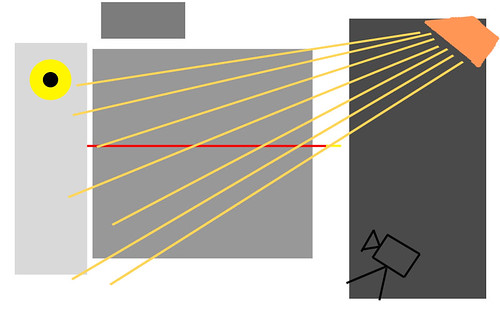When I noticed lighting was going to be the main topic for this week, I attempted to stay alert. I have worked on film sets before but have never really had the opportunity to speak with the lighting technicians about how they actually create a particular effect or why they decided to use that light in that position instead of doing it the other way around (Yes, I realise there are a number of occasions where I have admitted by inability to use these situations to my advantage, don't remind me). So, I definitely found Malkiewicz's Film Lighting: Talks with Hollywood Cinematographers and Gaffers really useful.
Firstly, it taught me that filming in a studio was the best method for filming if possible. In our case, it's not because we will be filming in a house in a small room at night but the next part of the reading was exceptionally helpful.
Titled Night Interior, this section dictates that the sets are lit separately from the action. This means that the illusion of night is created by the direction and distribution of light. Other notes state that the angle of the light tends to be more frontal whilst the percentage of the area lit is smaller. The general strategy undertaken is to underlight objects in relation to the set behind them, illuminating the foreground. If we think about this in relation to real life, I would say that this is the most natural replication of lighting at night. Just by sitting in my room at the moment, I can tell that object layered in front of others are covered in more light than those behind them. This is justified by the fact that during the day, there are so many light rays permeating a room that they bounce off other objects and illuminate the back of objects as well as the front. When you only have a small 45watt bulb lighting a room, it just doesn't have enough power to recreate the daylight you get in the middle of the day.
Richmond Aguilar comments on the difficulties of using multiple external-frame light sources which can cause problems with people walking around the frame. He states that the best way to achieve a successful night lightscape is to provide as many in-frame light sources as possible. This provides justification for lighting of the scene outside the frame and reduces the chance of shadows playing across your scene. He also suggests that when lighting faces, its better to use one light in a position which will be able to light as much of the scene as possible than a range of lights at different angles.
Luckily for us, our film is shot almost entirely along a single 180° line which means we could have a single light source on the other side of the line lighting our actor when we are filming him and then swapping that light to the other side of the room when we are filming in the opposite direction. I drew out a little diagram to illustrate what I'm rambling on about:
In this illustration, the lamp on top of the TV cabinet is the primary justification for having a Blondie or Kino in the corner. To get that tungsten effect, I would like to use a Blondie but it may be too big for the space so I think a Kino with a yellow gel on top of a diffuser to recreate that natural colour without that intensity.

In the second illustration, I'm hoping that when filming from the other side, we will simply be able to switch the external-frame light source to the other side aswell. Obviously, we would not use the same type of light as the set dictates a less saturated lightscape of the TV cabinet due to the fact that there is less of a light source, save for the light on top of the TV cabinet.

That light is actually starting to worry me. Generally, table lamps create a small pool of light and then have a degree of shadow which originates outside that pool. When Grant is fumbling with the set top box, the edge of the cabinet maybe outside the lamp's light pool, drowning it in shadows. There will also be the light source of the TV itself coming from underneath Grant. Basically, I have no idea how to answer any of these questions so I will have to remember to discuss this tricky situation with Deanna and Arthur at the camera rehearsal on Monday and then with Robin if I get the chance to see him before Friday's shoot.



0 comments:
Post a Comment